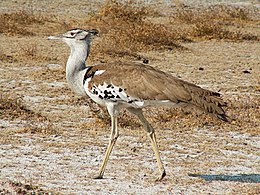Bustards
| Bustards Temporal range: Miocene – Holocene, 13–0 Ma |
|
|---|---|
 |
|
| Kori bustard (Ardeotis kori) | |
| Scientific classification | |
| Kingdom: | Animalia |
| Phylum: | Chordata |
| Class: | Aves |
| Clade: | Otidimorphae |
| Order: |
Otidiformes Wagler, 1830 |
| Family: |
Otididae Rafinesque, 1815 |
| Genera | |
|
Heterotetrax |
|
Heterotetrax
Lissotis
Ardeotis
Tetrax
Houbaropsis
Sypheotides
Lophotis
Otis
Chlamydotis
Eupodotis
Bustards, including floricans and korhaans, are large, terrestrial birds living mainly in dry grassland areas and on the steppes of the Old World. They range in length from 40 to 150 cm (16 to 59 in). They make up the family Otididae (formerly known as Otidae). Bustards are omnivorous and opportunistic, eating leaves, buds, seeds, fruit, small vertebrates, and invertebrates.
Bustards are all fairly large with the two largest species, the kori bustard (Ardeotis kori) and the great bustard (Otis tarda), being frequently cited as the world's heaviest flying birds. In both the largest species, large males exceed a weight of 20 kg (44 lb), weigh around 13.5 kg (30 lb) on average and can attain a total length of 150 cm (59 in). The smallest species is the little brown bustard (Eupodotis humilis), which is around 40 cm (16 in) long and weighs around 600 g (1.3 lb) on average. In most bustards, males are substantially larger than females, often about 30% longer and sometimes more than twice the weight. They are among the most sexually dimorphic groups of birds. In only the is the sexual dimorphism reverse, with the adult female being slightly larger and heavier than the male.
...
Wikipedia
